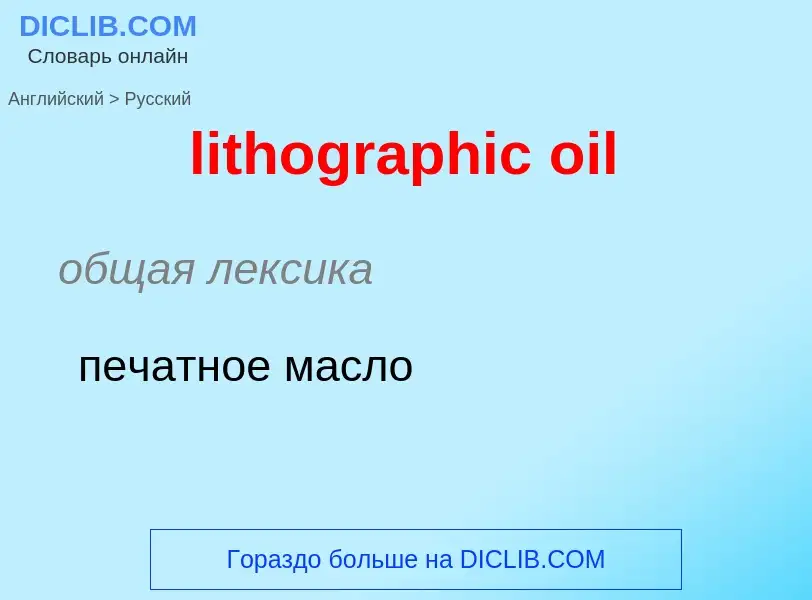Vertaling en analyse van woorden door kunstmatige intelligentie ChatGPT
Op deze pagina kunt u een gedetailleerde analyse krijgen van een woord of zin, geproduceerd met behulp van de beste kunstmatige intelligentietechnologie tot nu toe:
- hoe het woord wordt gebruikt
- gebruiksfrequentie
- het wordt vaker gebruikt in mondelinge of schriftelijke toespraken
- opties voor woordvertaling
- Gebruiksvoorbeelden (meerdere zinnen met vertaling)
- etymologie
lithographic oil - vertaling naar russisch
общая лексика
печатное масло
[pi:nʌt'ɔil]
общая лексика
арахисовое масло
ореховое масло
Wikipedia
.jpg?width=120)
Lithography (from Ancient Greek λίθος, lithos 'stone', and γράφειν, graphein 'to write') is a planographic method of printing originally based on the immiscibility of oil and water. The printing is from a stone (lithographic limestone) or a metal plate with a smooth surface. It was invented in 1796 by the German author and actor Alois Senefelder and was initially used mostly for musical scores and maps. Lithography can be used to print text or images onto paper or other suitable material. A lithograph is something printed by lithography, but this term is only used for fine art prints and some other, mostly older, types of printed matter, not for those made by modern commercial lithography.
Originally, the image to be printed was drawn with a greasy substance, such as oil, fat, or wax onto the surface of a smooth and flat limestone plate. The stone was then treated with a mixture of weak acid and gum arabic ("etch") that made the parts of the stone's surface that were not protected by the grease more hydrophilic (water attracting). For printing, the stone was first moistened. The water only adhered to the gum-treated parts, making them even more oil-repellant. An oil-based ink was then applied, and would stick only to the original drawing. The ink would finally be transferred to a blank paper sheet, producing a printed page. This traditional technique is still used for fine art printmaking.
In modern commercial lithography, the image is transferred or created as a patterned polymer coating applied to a flexible plastic or metal plate. The printing plates, whether stone or metal, can be created by a photographic process, a method that may be referred to as "photolithography" (although the term usually refers to a vaguely similar microelectronics manufacturing process). Offset printing or "offset lithography" is an elaboration of lithography in which the ink is transferred from the plate to the paper by means of a rubber plate or cylinder, rather than by direct contact of the two. This technique keeps the paper dry and allows high speed fully automated operation. It has mostly replaced traditional lithography for medium- and high-volume printing: since the 1960s, most books and magazines, especially when illustrated in colour, are printed with offset lithography from photographically created metal plates.
As a printing technology, lithography is different from intaglio printing (gravure), wherein a plate is engraved, etched, or stippled to score cavities to contain the printing ink; and woodblock printing or letterpress printing, wherein ink is applied to the raised surfaces of letters or images.

.jpg?width=200)
![''Self Portrait with Skeleton Arm'' by [[Edvard Munch]] ''Self Portrait with Skeleton Arm'' by [[Edvard Munch]]](https://commons.wikimedia.org/wiki/Special:FilePath/Edvard Munch - Self-Portrait (1895) G0192-59 - Google Art Project.jpg?width=200)

![[[Sea anemone]]s from [[Ernst Haeckel]]'s ''[[Kunstformen der Natur]]'' (''Artforms of Nature''), 1904 [[Sea anemone]]s from [[Ernst Haeckel]]'s ''[[Kunstformen der Natur]]'' (''Artforms of Nature''), 1904](https://commons.wikimedia.org/wiki/Special:FilePath/Haeckel Actiniae.jpg?width=200)

![Lithography machine in [[Bibliotheca Alexandrina]] Lithography machine in [[Bibliotheca Alexandrina]]](https://commons.wikimedia.org/wiki/Special:FilePath/Lithography machine in Bibliotheca Alexandrina.jpg?width=200)


![Lithography stone and [[mirror image]] print of a map of Munich Lithography stone and [[mirror image]] print of a map of Munich](https://commons.wikimedia.org/wiki/Special:FilePath/Litography negative stone and positive paper.jpg?width=200)

![''Smiling Spider'' by [[Odilon Redon]], 1891 ''Smiling Spider'' by [[Odilon Redon]], 1891](https://commons.wikimedia.org/wiki/Special:FilePath/Redon smiling-spider.jpg?width=200)

![Hé! La chian..... li....li....li..... [It's a blood...dy...dy...dy... mess], lithograph of [[Louis-Philippe of France]] by [[Honoré Daumier]], 1834 Hé! La chian..... li....li....li..... [It's a blood...dy...dy...dy... mess], lithograph of [[Louis-Philippe of France]] by [[Honoré Daumier]], 1834](https://commons.wikimedia.org/wiki/Special:FilePath/Honoré Daumier, Hé! La chian..... li....li....li.....jpg?width=200)
![Butterflies from [[Adalbert Seitz]]'s ''Macrolepidoptera of the World'' (1923) Butterflies from [[Adalbert Seitz]]'s ''Macrolepidoptera of the World'' (1923)](https://commons.wikimedia.org/wiki/Special:FilePath/Macrolepidoptera15seit 0215.jpg?width=200)
![An 1836 lithograph of Mexican women making [[tortilla]]s by [[Carl Nebel]] An 1836 lithograph of Mexican women making [[tortilla]]s by [[Carl Nebel]]](https://commons.wikimedia.org/wiki/Special:FilePath/Tortilleras Nebel.jpg?width=200)
![Dourraunee]] chieftains in full armour, 1847 Dourraunee]] chieftains in full armour, 1847](https://commons.wikimedia.org/wiki/Special:FilePath/Afghan royal soldiers of the Durrani Empire.jpg?width=200)
![William Simpson]] (1859). William Simpson]] (1859).](https://commons.wikimedia.org/wiki/Special:FilePath/William Simpson - George Zobel - England and America. The visit of her majesty Queen Victoria to the Arctic ship Resolute - December 16th, 1856.jpg?width=200)
![Champagne Charlie]]'' Champagne Charlie]]''](https://commons.wikimedia.org/wiki/Special:FilePath/GeorgeLeybourne2.jpg?width=200)
![''[[At Eternity's Gate]]'', 1882 lithograph by [[Vincent van Gogh]] ''[[At Eternity's Gate]]'', 1882 lithograph by [[Vincent van Gogh]]](https://commons.wikimedia.org/wiki/Special:FilePath/Old Man with his Head in his Hands (At Eternity's Gate).jpg?width=200)

![''In the Park, Light'' – [[George Bellows]] 1916 ''In the Park, Light'' – [[George Bellows]] 1916](https://commons.wikimedia.org/wiki/Special:FilePath/Brooklyn Museum - In the Park, Light - George Wesley Bellows - overall.jpg?width=200)
![Emperors of Brazil]], 19th-century lithograph by [[Jean-Baptiste Debret]] Emperors of Brazil]], 19th-century lithograph by [[Jean-Baptiste Debret]]](https://commons.wikimedia.org/wiki/Special:FilePath/Jean-Baptiste Debret - Vista do Paço de São Cristovão.jpg?width=200)

